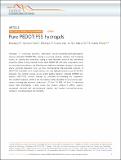Pure PEDOT:PSS hydrogels
Author(s)
Lu, Baoyang; Yuk, Hyunwoo; Lin, Shaoting; Jian, Nannan; Qu, Kai; Xu, Jingkun; Zhao, Xuanhe; ... Show more Show less
DownloadPublished version (3.020Mb)
Terms of use
Metadata
Show full item recordAbstract
© 2019, The Author(s). Hydrogels of conducting polymers, particularly poly(3,4-ethylenedioxythiophene):poly(styrene sulfonate) (PEDOT:PSS), provide a promising electrical interface with biological tissues for sensing and stimulation, owing to their favorable electrical and mechanical properties. While existing methods mostly blend PEDOT:PSS with other compositions such as non-conductive polymers, the blending can compromise resultant hydrogels’ mechanical and/or electrical properties. Here, we show that designing interconnected networks of PEDOT:PSS nanofibrils via a simple method can yield high-performance pure PEDOT:PSS hydrogels. The method involves mixing volatile additive dimethyl sulfoxide (DMSO) into aqueous PEDOT:PSS solutions followed by controlled dry-annealing and rehydration. The resultant hydrogels exhibit a set of properties highly desirable for bioelectronic applications, including high electrical conductivity (~20 S cm −1 in PBS, ~40 S cm −1 in deionized water), high stretchability (> 35% strain), low Young’s modulus (~2 MPa), superior mechanical, electrical and electrochemical stability, and tunable isotropic/anisotropic swelling in wet physiological environments.
Date issued
2019Department
Massachusetts Institute of Technology. Department of Mechanical Engineering; Massachusetts Institute of Technology. Department of Civil and Environmental EngineeringJournal
Nature Communications
Publisher
Springer Science and Business Media LLC